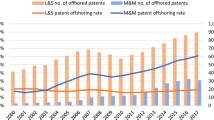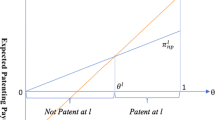Abstract
In the current discourse about the technological development of emerging market multinational companies (EM MNCs), the internationalization of research and development (R&D) activities is increasingly discussed as a strategy for catching-up to established MNCs. EM MNCs attempt to use international R&D to tap into technologically superior resources abroad which are not available to them in their home market. This study compares the performance of domestic and offshore R&D activities to look into EM MNCs’ ability to conduct high-quality R&D abroad. We use the Chinese telecommunication equipment manufacturer Huawei as a best practice case study. To map their worldwide patent quality pattern, we propose a multiple-patent-office-approach to ensure a balanced view on their activities with data from SIPO, USPTO and EPO. We also employ three different measures to capture different dimensions of patent quality. The results of the empirical model support the assumption of higher quality for patents with knowledge from advanced offshore locations.




Similar content being viewed by others
References
Albert, M. B., Avery, D., Narin, F., & McAllister, P. (1991). Direct validation of citation counts as indicators of industrially important patents. Research Policy, 20(3), 251–259. doi:10.1016/0048-7333(91)90055-U.
Awate, S., Larsen, M. M., & Mudambi, R. (2014). Accessing vs sourcing knowledge: A comparative study of R&D internationalization between emerging and advanced economy firms. Journal of International Business Studies, 46(1), 1–24. doi:10.1057/jibs.2014.46.
Blind, K., Edler, J., Frietsch, R., & Schmoch, U. (2006). Motives to patent: Empirical evidence from germany. Research Policy, 35(5), 655–672. doi:10.1016/j.respol.2006.03.002.
Carpenter, M., Narin, F., & Woolf, P. (1981). Citation rates to technologically important patents. World Patent Information, 3(4), 160–163. doi:10.1016/0172-2190(81)90098-3.
Chen, S. H. (2004). Taiwanese it firms’ offshore R&D in china and the connection with the global innovation network. Research Policy, 33(2), 337–349. doi:10.1016/j.respol.2003.09.003.
Chen, S. H., & Wen, P. C. (2016). The evolution of china’s mobile phone industry and good-enough innovation. In Y. Zhou, W. Lazonick & Y. Sun (Eds.), China as an innovation nation (pp. 261–282). Oxford: Oxford University Press.
Chen, V. Z., Li, J., & Shapiro, D. M. (2012). International reverse spillover effects on parent firms: Evidences from emerging-market mnes in developed markets. European Management Journal, 30(3), 204–218. doi:10.1016/j.emj.2012.03.005.
Child, J., & Rodrigue, S. (2005). The internationalization of chinese firms: A case for theoretical extension? Management and Organizational Review, 1(3), 381–410. doi:10.1111/j.1740-8784.2005.0020a.x.
Cohen, W. M., & Levinthal, D. (1990). Absorptive capacity: A new perspective on learning and innovation. Administrative Science Quarterly, 35(1), 128–152. doi:10.2307/2393553.
Criscuolo, P. (2006). The ’home advantage’ effect and patent families. A comparison of oecd triadic patents, the uspto and the epo. Scientometrics, 66(1), 23–41. doi:10.1007/s11192-006-0003-6.
Dang, J., & Motohashi, K. (2015). Patent statistics: A good indicator for innovation in china? patent subsidy program impacts on patent quality. China Economic Review, 35, 137–155. doi:10.1016/j.chieco.2015.03.012.
Denk, N., Kaufmann, L., & Roesch, J. F. (2012). Liabilities of foreignness revisited: A review of contemporary studies and recommendations for future research. Journal of International Management, 18(4), 322–334. doi:10.1016/j.intman.2012.07.001.
Di Minin, A., Zhang, J., & Gammeltoft, P. (2012). Chinese foreign direct investment in r&d in europe: A new model of R&D internationalization? European Management Journal, 30(3), 189–203. doi:10.1016/j.emj.2012.03.004.
Fan, P. (2011). Innovation, globalization, and catch-up of latecomers: Cases of chinese telecom firms. Environment and Planning A, 43(A), 830–849. doi:10.1068/a43152.
Fischer, T., & Leidinger, J. (2014). Testing patent value indicators on directly observed patent value—An empirical analysis of ocean tomo patent auctions. Research Policy, 43(3), 519–529. doi:10.1016/j.respol.2013.07.013.
Frietsch, R., & Schmoch, U. (2010). Transnational patents and international markets. Scientometrics, 82(1), 185–200. doi:10.1007/s11192-009-0082-2.
Frietsch, R., Schmoch, U., van Looy, B., Walsh, J. P., Devroede, R., Du Plessis, M., et al. (2010). The value and indicator function of patents. Studien zum deutschen Innovationssystem, vol Nr. 15-2010. Expertenkommission Forschung und Innovation (EFI), Berlin.
Fu, X., & Gong, Y. (2011). Indigenous and foreign innovation efforts and drivers of technological upgrading: Evidence from china. World Development, 39(7), 1213–1225. doi:10.1016/j.worlddev.2010.05.010.
Fu, X., & Sun, Z. (2015). Internationalisation, reverse learning and capabilities upgrading: The case of huawei and zte. In: China’s path to innovation (pp. 279–313).
Gassmann, O., & von Zedtwitz, M. (1998). Organization of industrial R&D on a global scale. R&D Management, 28(3), 147–161. doi:10.1111/1467-9310.00092.
Görg, H., & Greenaway, D. (2004). Much ado about nothing? Do domestic firms really benefit from foreign direct investment? The World Bank Research Observer, 19(2), 171–197. doi:10.1093/wbro/lkh019.
Grupp, H. (1998). Foundations of the economics of innovation: Theory. Measurement and practice: New horizons in the economics of innovation. Northampton: Edgar Elgar Publishing Ltd.
Hall, B., & MacGarvie, M. (2010). The private value of software patents. Research Policy, 39(7), 994–1009. doi:10.1016/j.respol.2010.04.007.
Hall, B., Jaffe, A., & Trajtenberg, M. (2005). Market value and patent citations. RAND Journal of Economics, 36(1), 16–38. doi:10.3386/w7741.
Harhoff, D., Scherer, F., & Vopel, K. (2003). Citations, family size, opposition and the value of patent rights. Research Policy, 32(8), 1343–1363. doi:10.1016/S0048-7333(02)00124-5.
He, W., & Lyles, M. A. (2008). China’s outward foreign direct investment. Business Horizons, 51(6), 485–491. doi:10.1016/j.bushor.2008.06.006.
Hsu, C. W., Lien, Y. C., & Chen, H. (2015). R&d internationalization and innovation performance. International Business Review, 24(2), 187–195. doi:10.1016/j.ibusrev.2014.07.007.
Huawei (2014). Annual report 2014. Huawei Investment & Holding Co, Ltd.
Jindra, B., Hassan, S. S., & Cantner, U. (2014). What does location choice reveal about knowledge-seeking strategies of emerging market multinationals in the eu? International Business Review, 25(1), 204–220. doi:10.1016/j.ibusrev.2014.11.008.
Johanson, J., & Vahlne, J. E. (2009). The uppsala internationalization process model revisited: From liability of foreignness to liability of outsidership. Journal of International Business Studies, 40(9), 1411–1431. doi:10.1057/jibs.2009.24.
Kuemmerle, W. (1997). Building effective r&d capabilities abroad. In Harvard business review (pp. 61–70).
Lahiri, N. (2010). Geographic distribution of R&D activity: How does it affect innovation quality? Academy of Management Journal, 53(5), 1194–1209. doi:10.5465/AMJ.2010.54533233.
Lanjouw, J. O., & Schankermann, M. (2004). Patent quality and research productivity: Measuring innovation with multiple indicators. The Economic Journal, 114, 441–465. doi:10.1111/j.1468-0297.2004.00216.x.
Lanjouw, J. O., Pakes, A., & Putnam, J. (1998). How to count patents and value intellectual property: The uses of patent renewal and application data. The Journal of Industrial Economics XLV, I(4), 405–433. doi:10.1111/1467-6451.00081.
Li, X. (2012). Behind the recent surge of chinese patenting: An institutional view. Research Policy, 41(1), 236–249. doi:10.1016/j.respol.2011.07.003.
Liefner, I., & Zeng, G. (2016). China’s mechanical engineering industry: Offering the potential for indigenous innovation? In Y. Zhou, W. Lazonick & Y. Sun (Eds.), China as an innovation nation (pp. 98–132). Oxford: Oxford University Press.
Liefner, I., Si, Y., & Schaefer, K. J. (2015). Host country knowledge absorption and emnc global innovation: an analysis of huawei’s R&D collaborations in germany. Paper presented at the workshop “Technology driven FDI from emerging countries: Challenges and opportunities for Europe”, Scuola Superiore Sant’Anna, Pisa, Italy, 28–29 May 2015.
Liefner, I., Kroll, H., & Peighambari, A. (2016). Research-driven or party-promoted? Factors affecting patent applications of private smes in china’s pearl river delta. Science and Public Policy, 43(6). doi:10.1093/scipol/scw002.
Low, B. (2007). Huawei technologies corporation: From local dominance to global challenge? Journal of Business & Industrial Marketing, 22(2), 138–144. doi:10.1108/08858620710730258.
Luo, Y., & Tung, R. L. (2007). International expansion of emerging market enterprises: A springboard perspective. Journal of International Business Studies, 38(4), 481–498. doi:10.1057/palgrave.jibs.8400275.
Mathews, J. A. (2002). Competitive advantages of the latecomer firm: A resource-based account of industrial catch-up strategies. Asia Pacific Journal of Management, 19, 467–488. doi:10.1023/A:1020586223665.
Messinis, G. (2011). Triadic citations, country biases and patent value: The case of pharmaceuticals. Scientometrics, 89(3), 813–833. doi:10.1007/s11192-011-0473-z.
Miller, S., & Eden, L. (2006). Local density and foreign subsidiary performance. Academy of Management Journal, 49(2), 341–355. doi:10.5465/AMJ.2006.20786081.
Miller, S., & Parkhe, A. (2002). Is there a liability of foreignness in global banking? An empirical test of banks’ x-efficiency. Strategic Management Journal, 23(1), 55–75. doi:10.1002/smj.212.
Mu, Q., & Lee, K. (2005). Knowledge diffusion, market segmentation and technological catch-up: The case of the telecommunication industry in china. Research Policy, 34(6), 759–783. doi:10.1016/j.respol.2005.02.007.
Nahm, J., & Steinfeld, E. S. (2014). Scale-up nation: China’s specialization in innovative manufacturing. World Development, 54, 288–300. doi:10.1016/j.worlddev.2013.09.003.
Neuhäusler, P. (2012). The use of patents and informal appropriation mechanisms—Differences between sectors and among companies. Technovation, 32(12), 681–693. doi:10.1016/j.technovation.2012.07.004.
Penner-Hahn, J., & Shaver, J. M. (2005). Does international research and development increase patent output? an analysis of japanese pharmaceutical firms. Strategic Management Journal, 26(2), 121–140. doi:10.1002/smj.436.
Poon, J. P. H., Hsu, J. Y., & Jeongwook, S. (2006). The geography of learning and knowledge acquisition among asian latecomers. Journal of Economic Geography, 6(4), 541–559. doi:10.1093/jeg/lbi021.
Rosenkopf, L., & Nerkar, A. (2001). Beyond local search: Boundary-spanning, exploration, and impact in the optical disk industry. Strategic Management Journal, 22(4), 287–306. doi:10.1002/SMJ.160.
Schmoch, U. (2008). Concept of a technology classification for country comparisons. Final report to the world intellectual property organisation.
Serapio, M., & Dalton, D. (1999). Globalization of industrial R&D: An examination of foreign direct investment in R&D in the united states. Research Policy, 28, 303–316. doi:10.1016/S0048-7333(98)00109-7.
Si, Y., & Liefner, I. (2014). Cognitive distance and obstacles to subsidiary business success: The experience of chinese companies in germany. Tijdschrift voor Economische en Sociale Geografie, 105(3), 285–300. doi:10.1111/tesg.12064.
Singh, J. (2008). Distributed R&D, cross-regional knowledge integration and quality of innovative output. Research Policy, 37(1), 77–96. doi:10.1016/j.respol.2007.09.004.
Sofka, W. (2006). Innovation activities abroad and the effect of liability of foreigness: Where it hurts. ZEW Discussion Paper, 6(29), 1–22.
Squicciarini, M., Criscuolo, C., & Dernis, H. (2013). Measuring patent quality. OECD Science, Technology and Industry Working Papers, 03(03). doi:10.1787/5k4522wkw1r8-en.
Ter Wal, A. L. J., & Boschma, R. A. (2009). Applying social network analysis in economic geography: Framing some key analytic issues. The Annals of Regional Science, 43(3), 739–756. doi:10.1007/s00168-008-0258-3.
Trajtenberg, M. (1990). A penny for your quotes: Patent citations and the value of innovations. The RAND Journal of Economics, 21(1), 172–187.
van Zeebroeck, N., & van Pottelsberghe de la Potterie B,. (2011). Filing strategies and patent value. Economics of Innovation and New Technology, 20(6), 539–561. doi:10.1080/10438591003668646.
von Zedtwitz, M., & Gassmann, O. (2002). Market versus technology drive in R&D internationalization: Four different patterns of managing research and development. Research Policy, 31, 569–588.
Wan, F., Williamson, P. J., & Yin, E. (2015). Antecedents and implications of disruptive innovation: Evidence from china. Technovation, 39–40, 94–104. doi:10.1016/j.technovation.2014.05.012.
WIPO (2015). World intellectual property indicators. In Economics & statistics series (pp. 6–72).
Zaheer, S. (1995). Overcoming the liability of foreignness. Academy of Management Journal, 38(2), 341–363. doi:10.2307/256683.
Zuur, A. F., Ieno, E. N., Walker, N. J., Saveliev, A. A., & Smith, G. M. (2009). Mixed effects models and extensions in ecology with R. Statistics for biology and health. Berlin: Springer.
Acknowledgements
We would like to thank Rainer Frietsch and Peter Neuhäusler at the Fraunhofer Institute for Systems and Innovation Research ISI for access to their PATSTAT database, their support in retrieving the data and their methodological input regarding the subject of patent analysis. An earlier version of this paper was presented at the AAG annual meeting 2016. We would also like to thank Arianna Martinelli as well as Jaeyong Song and Mike Peng at the IACMR Conference 2016 for comments and suggestions as well as an anonymous reviewer for providing valuable feedback on the paper. Furthermore, we wish to thank Lisett Diehl for the cartographic artwork, Fiete Krass for supplementary data research as well as bibliographic formalities, and Kerry Jago for proofreading. We acknowledge funding from the Foundation German-American Academic Relations (Grant Number: T260/25622/2014/kg).
Author information
Authors and Affiliations
Corresponding author
Rights and permissions
About this article
Cite this article
Schaefer, K.J., Liefner, I. Offshore versus domestic: Can EM MNCs reach higher R&D quality abroad?. Scientometrics 113, 1349–1370 (2017). https://doi.org/10.1007/s11192-017-2533-5
Received:
Published:
Issue Date:
DOI: https://doi.org/10.1007/s11192-017-2533-5




